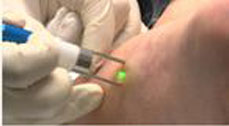Due to the nature of everyday life, the skin of the foot is regularly exposed to a large number of bacteria, viruses and fungi. Socks, shoes, dirty surfaces — the foot is often in direct contact with transmission zones and breeding grounds for infectious organisms. As such, we frequently find signs of fungal infection (athlete’s foot), viral infection (plantar warts) and bacterial infection (Erythrasma). Skin may also be affected with systemic changes, such as psoriasis.
Athlete’s Foot (Fungal Infection)
Athlete’s foot, a common tinea (fungal infection), is a foot infection that generally begins in the webbed spaces between toes. As the name suggests, athlete’s foot often affects athletes more than others, as the fungus requires a warm and moist environment, such as a shoe, to incubate. Transmission occurs when those who regularly wear shoes expose bare feet to humid shared spaces, like in locker rooms, before putting on shoes.
Common symptoms of athlete’s foot include redness, itching, cracking and peeling of the skin, often between the fourth and fifth toes. If cracking occurs, the potential for bacterial infection increases. While irritating, athlete’s foot is not serious or life-threatening. However, it’s important to treat these problem areas immediately upon discovery to prevent growth and subsequent discomfort. The infection is simple to diagnose, but depending on the type and extent of infection, treatment may vary. Consult with a chiropodist before choosing a treatment.
Plantar Warts (Viral infection)
Plantar warts are round, hard, painful lesions that look similar to corns (which they’re often confused for) but tend to have characteristic small black dots in the centre. Plantar warts are caused by a virus, which invades the foot through the soles or a break in the skin. Several plantar warts may cluster together. Striations form around, rather than over, the lesion. Depending on location, the growth is painful, especially when squeezed. It’s also contagious and will multiply and spread to other parts of the body, or people who are in regular contact, if left untreated.
If symptoms such as pain, redness, swelling or even bleeding surface, medical treatment is required. There are many effective and relatively painless types of treatments that when combined with topical medications will eliminate the condition without leaving a scar. Treatment methods range from simple acids to freezing of the wart tissue. Consult a chiropodist to evaluate treatment options.
New Laser Treatment for Plantar Warts
(by coagulation and carbonization)

Erythrasma (Bacterial Infection)
Erythrasma is a bacterial infection that results in brown, scaly skin patches. At the onset of this skin disease, patches are pink and well defined, which is why it can be confused with a fungal infection. Erythrasma, however, progresses rather rapidly, quickly changing to brown and scaly as skin sheds. The rash commonly occurs between the third and fourth toes, but can also develop in armpits, groin, under breasts or other regions where skin
folds.
Besides the markings, however, the patient shows no other symptoms. A Wood’s lamp is needed to make proper diagnosis. The ultraviolent light it generates fluoresces the specific bacteria, known medically as Corynebacterium minutissimum, which differentiates this skin disease from other fungal infections and/or skin conditions. Because erythrasma is a bacterial infection, treatment requires antibiotics, such as topical fusidic acid or systemic macrolides. Consult with a chiropodist for more treatment information.
Psoriasis (Skin Changes)
Psoriasis is a skin disease that occurs when the immune system mistakes regular skin for a pathogen and incorrectly transmits signals triggering the overproduction of new skin cells. There are five types of psoriasis — plaque, guttate, inverse, pustular and erythrodermic — with varying degrees of symptoms. Infected areas generally become covered with pink rashes and scaly patches that can cause itching, swelling and even pain. While it normally occurs on the skin of knees and elbows, psoriasis can affect any part of the body, including the soles of your feet.
Psoriasis is not contagious, but is a lifelong condition with no existing cure. Its cause is unknown, though a genetic component is believed to be at its root. There are, however, various treatments, such as topical medication, available to help keep symptoms under control. Speak with a chiropodist for more information.
